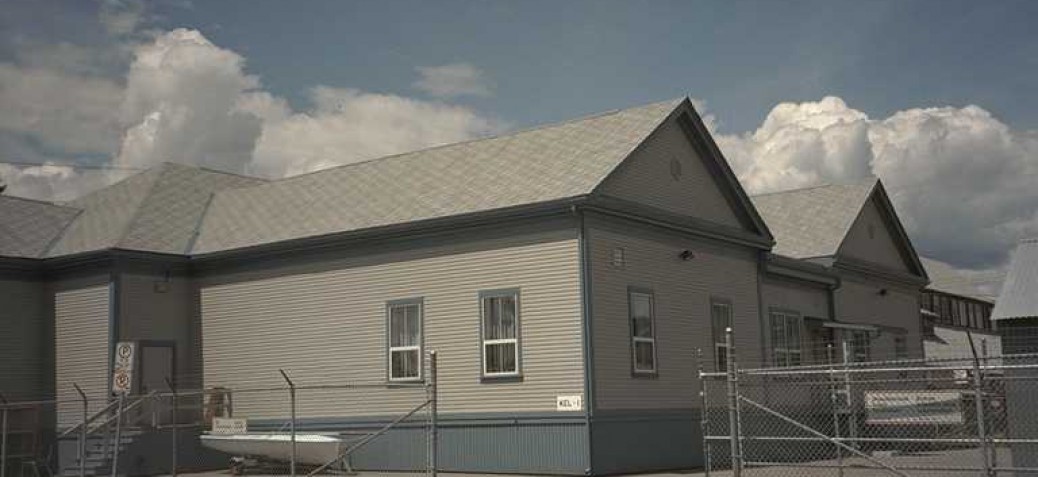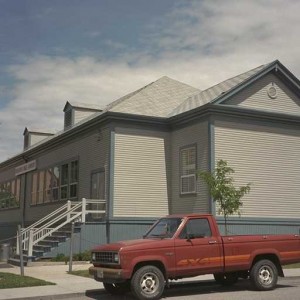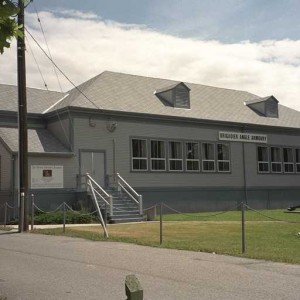Brigadier Angle Armoury
Place Description
The historic place is the single-storey wood-sided Brigadier Angle Armoury, built in 1904 with formal massing, and located at 720 Lawrence Avenue, in Kelowna's North Central neighbourhood. The Women's Institute next door on Lawrence Avenue and the brick school across the street are closely associated with the historic place, but do not comprise part of it.
Heritage Value
This building has its heritage value in its two important uses over the years. Its distinction as the oldest surviving public school building in Kelowna symbolizes the importance of public education to the community; and its current function as an armoury embodies the military heritage of the city. It also has value for representing the use of standard plans in school construction, and for its association with Lt. Col. Harry H. Angle.
The wood-frame building was constructed in 1904 as a four-room school, to replace the smaller one-room school on Bernard Avenue, which had been built in 1894. It is representative of many schools throughout the province, also built expediently and following standard plans, in order to keep up with the rapidly growing population. The building has value for its simple, utilitarian, well-proportioned design, the four original classrooms clearly expressed in the clusters of six windows and the separate entrances, all contained within a medium-hipped roof. Utility wings occupy the ends. The formality of the plan reflects the Beaux-Arts-influenced public architecture of the day, albeit rendered in modest materials.
The school accommodated all grades. This included the high school, which began in 1907 in one room under the charge of Elizabeth McNaughton, who taught all subjects in the 3-year high school program. Kelowna's continuing rapid growth soon left the school bursting at the seams. A new brick school across Lawrence Avenue opened in 1910, accommodating the high school and several lower grades. This building continued in use as a school for some time. In 1925 the manual skills training ('industrial arts') class moved out of the basement of this building into its own building next door (now the Women's Institute, at 770 Lawrence Avenue) - a structure that the class had itself built a year earlier under the direction of its teacher, W.C. Mitchell.
This building ceased use as a school in 1929, after the construction of DeHart Avenue Primary School in 1928 and the Junior High School in 1929 opened up space elsewhere. It had been sold for demolition when in 1935 the Department of National Defence offered the city of $1,000 for the building and the lots on which it stood. The building was remodeled and adapted for use as an armoury. This established a base for the Kelowna squadron of the British Columbia Dragoons, the Okanagan unit of the Non-Permanent Active Militia. This regiment had a distinguished history dating back to 1908, when a squadron of the Canadian Mounted Rifles had been formed at Vernon. The unit was converted to an active regiment, the 2nd Canadian Mounted Rifles, for service in World War I. The militia unit was revived as the British Columbia Dragoons from 1920 to 1939. At the outbreak of World War II, the BC Dragoons were mobilized as the 5th Canadian Armoured Regiment and in 1941 remustered as the 9th Canadian Armoured Regiment. It fought in Italy and the Low Countries. From 1943 to the end of the war, the regiment was commanded by Lt. Col. Harry H. Angle, who had farmed at Okanagan Mission in the 1930s. On return from overseas, the BC Dragoons (B Squadron, Kelowna) resumed militia activity as part of the Canadian Forces Primary Reserves, operating out of this armoury with evening parades, weekend exercises, and summer concentrations. The Dragoons share the building with the Kelowna unit of the Royal Canadian Army Cadets, formed in 1942.
H.H. Angle, with whom the building is closely associated, provides added value to the historic place. He commanded the BC Dragoons reserve unit for two years, as well as being appointed a local magistrate. In 1948 he was recalled to active duty, to serve as Canadian representative on the United Nations mission to the Indian subcontinent. He was the first Canadian serviceman to die during peacekeeping duties, when the plane he was traveling in from New Delhi to Kashmir crashed on July 17, 1950.
This building was formally dedicated as the
Character Defining Elements
- Raised one storey building set well back on the site
- Hipped main roof, gabled wings, gabled dormers, shed roofs beside entries
- The building is representative of an early style of school building, utilitarian, but well proportioned
- Gabled dormers are not glazed, but serve as vents to the attic space
- Pedimented end gables, with round vents located on the centre line of the ridge
- Horizontal, beveled wood siding
- Foundation level marked by change in the sheathing material and colour
- Large, grassed site, displaying tanks, cannon, and various military paraphernalia






